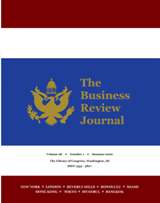|
The Omniscience Model:
Lagged Correlation
Dr. Jeffry Haber, Iona
College, NY
Patrick
Hardiman, Iona College, NY
ABSTRACT
The Omniscience Model is
an attempt to harness the nearly limitless flow of real-time financial
information with the geometric gains in computing power to predict future stock
prices. A previous paper (1) reviewed various mathematical and statistical
functions from a variety of fields to determine which would be applicable to
stock price prediction. Correlation was one metric selected that had potential.
Correlation is the relationship between two streams of data and can be any value
between (and including) -1.00 and +1.00. The extremes (-1.00 and +1.00)
represent perfect correlation, whereas values close to 0.00 indicate
non-correlation. The sign (positive or negative) indicates whether the
relationship is direct or inverse (respectively). In a direct relationship as
one stream increases the other stream would increase as well. In an inverse
relationship as one stream increases the other decreases. In an investing
context correlation is important because it represents the inference that can be
made by utilizing one stream of data to predict the value (or change in value)
of a second stream. The problem with correlation is that it is not investable.
Both streams of data are for the same temporal period, which means that by the
time you have finished the calculation the ability to invest has passed based on
the information provided by the correlation. This paper seeks to develop the
concept of lagged correlation – that is, where one stream of data is for period
t and is used to calculate the correlation with a second stream of data
at period t+x for possible use as a filter in The Omniscience Model.
Correlation is a ubiquitous metric in investing, usually used in the context of
how a fund or security behaves in relation to an index, benchmark or sector.
Many fund sponsors will tout that their fund is “uncorrelated” with stocks,
which would position their fund as a risk diversifier for a portfolio. Since
correlation is a widely-used statistic, it is not surprising that it has also
been widely researched. Most specifications of correlation are for extended
periods, such as 10 or 15 years. Studies have shown (2) that correlation
calculated over the long-term might not hold in shorter segments within this
longer term. The typical calculation is based on returns (as opposed to prices).
Full text
American Depository
Receipts: An Analysis of the Underlying Stock Returns
Dr. Chih-Chieh (Jason)
Chiu, Rider University, Lawrenceville, NJ
ABSTRACT
This paper examines option
listing effects on American Depository Receipts and their local counterparts. I
analyze a sample of 42 option listings from 15 different countries and obtain
negative price effects on the day after option listing. One possible explanation
for the findings is that option listing relaxes the short sale constraints for
the underlying securities. Do option listings have an impact on the underlying
securities? According to Arrow-Debreu uncertainty theory, option listings move
an incomplete stock market towards a state of equilibrium by increasing the
number of assets to hedge against different states of nature. Black and Scholes
(1973), however, see options as redundant assets and price them as such in their
renowned options model. Consequently, numerous options models assume
independence between stock and options market. Without a concrete theoretical
direction, I examine the option listing effects on the underlying American
Depository Receipts (1) (ADRs) and their local counterparts in the
home country. I find a negative price effect on the first day post option
listings. The negative abnormal returns are -0.66% and -0.64% for ADRs and their
local counterparts respectively. Empirical research has shown price effects of
option introductions on the underlying assets. The milestone paper by Conrad
(1989) suggests that option introductions have a permanent effect on stock
prices. Using a sample of 96 option listings for the period of 1974 to 1980, she
finds option introductions have a positive price effect starting three days
before introductions. She attributes the increases to the heightened demand for
stocks from traders. The positive price effect from option listing, however,
has been dampened by the introduction of options on the S&P 500 futures. Using a
sample of 300 option listings from 1973 to 1986, Detemple and Jorion (1990)
observe positive price effects and reduced volatility due to option listings.
Full text
The Dead-Weight of
Public Sector Companies in India: A Case Study
Dr. Anuja Gupta, Rutgers
University, Camden, NJ
ABSTRACT
The Indian economy
followed a socialistic model of economic development from 1947 to 1991, in which
the government played a very large role in economic activity in the country.
While liberalization started 25 years ago, there is still considerable
dead-weight in the economy in the form of persistently loss-making public sector
enterprises. Privatization, which was one of the planks of liberalization and a
potential solution to this dead weight problem, has not made much progress in
India. In this paper, we analyze the case of one such loss making public sector
unit (PSU) - Mahanagar Telephone Nigam Limited (MTNL) with a view to gaining
insight into the dire financial situation of many such PSUs. Further, we conduct
a comparative analysis of MTNL with a private player in the same industry thus
highlighting the glaring inefficiencies and poor performance of the PSU. We
argue that there is no economic or strategic logic of carrying this dead weight
in the economy. The assets tied up in these extremely inefficient companies
could be put to much better use in India, a country with growth needs and
ambitions. The
Indian economy was following a “socialistic” model of government and economic
development after its independence in 1947. This led to an economy that was
replete with government control, and with direct participation of the government
in economic activity through the ever-expanding public sector. In 1991, India
faced a balance of payments crisis which led to a bailout by the International
Monetary Fund (IMF) (Makhija, 2006). This, of course, came with stipulations to
open up the economy, and get rid of excessive regulations. Thus, the process of
liberalization started in 1991 with the government working on deregulation,
delicensing and privatization. While reasonable progress was made in
deregulation and delicensing, very little headway has been made in the area of
privatization. As of 2016, there are still 244 public sector units (PSUs) under
central government control. Only 14 PSUs have been fully privatized. In this
paper, we highlight the dire financial position that many PSUs are in, by
examining one such loss making PSU in-depth. We study the public sector
telecommunications services provider Mahanagar Telephone Nigam Limited (MTNL).
Full text
|

 The Business Review
Journal
The Business Review
Journal



.gif)